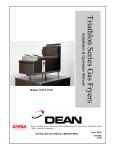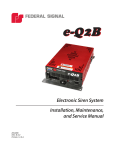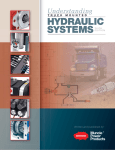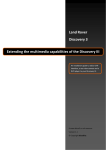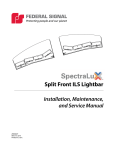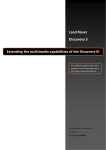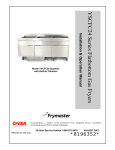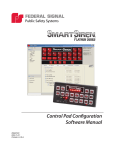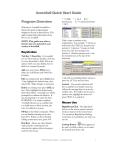Download Installation, Maintenance, and Service Manual 3
Transcript
3-Pod and Split Vision SLR™ Lightbars Installation, Maintenance, and Service Manual 2562678A REV. A 212 Printed in U.S.A. Solaris is a registered trademark of Federal Signal Corp. Vision SLR is a trademark of Federal Signal Corp. Torx is a registered trademarks of Accument Intellectual Properties, LLC Plexis is a registered tradenark of Gaymar Industries, Inc. Opticom is a trademark of Global Traffic Technologies, LLC Contents CHAPTER 1 Safety Messages for Installers and Operators.................................................5 Safety Messages to Installers of Warning Light Equipment......................................................................5 Safety Message to Operators of Warning Light Equipment......................................................................8 CHAPTER 2 An Overview of the 3-Pod and Split Vision Lightbars.....................................9 LED Lights and Colors..............................................................................................................................9 LED Flash Rates and Positions..................................................................................................................9 Control Options.........................................................................................................................................9 Dimensions..............................................................................................................................................10 Light Specifications.................................................................................................................................10 CHAPTER 3 Preparing for the Lightbar Installation............................................................ 11 Unpacking the Lightbar........................................................................................................................... 11 Determining the Mounting Location and Wire Routings........................................................................ 11 CHAPTER 4 Wiring the Lightbar in the Vehicle...................................................................13 Connecting Power to the Lightbar ..........................................................................................................13 Wiring the Control Cable for the Standard VSLR Lightbar....................................................................14 Wiring the Controls for White Light and Rear Light Cutoff ..................................................................15 CHAPTER 5 Programming Flash Patterns...........................................................................16 Programming Primary Mode...................................................................................................................16 Programming Secondary Mode...............................................................................................................17 CHAPTER 6 Maintaining and Servicing the Lightbar..........................................................21 Cleaning the Lightbar Domes..................................................................................................................21 Replacing a Dome....................................................................................................................................22 Replacing a Pod.......................................................................................................................................23 Replacing a Lightbar Controller..............................................................................................................25 Troubleshooting the Lightbar..................................................................................................................29 Getting Technical Support and Service...................................................................................................29 Ordering Replacement Parts....................................................................................................................30 Returning a Product to Federal Signal.....................................................................................................30 Contents Contents Table 4.1 Functions of 2-conductor power cable and 6-conductor control cable.......................................15 Table 5.1 Legends for VSLR flash patterns................................................................................................17 Table 5.2 3-Pod VSLR Flash Patterns.........................................................................................................18 Table 5.3 6-Pod VSLR Flash Patterns.........................................................................................................19 Table 5.4 8-Pod VSLR Flash Patterns.........................................................................................................20 Table 6.1 Troubleshooting tips....................................................................................................................29 Table 6.2 Replacement parts.......................................................................................................................30 Figures Figure 6.1 Dome removal and replacement................................................................................................22 Figure 6.2 Pods rotated for removal............................................................................................................24 Figure 6.3 Location of VSLR3 PCBA........................................................................................................26 Figure 6.4 Location of VSLR3 PCBA........................................................................................................27 Figure 6.5 Location of VSLR8 PCBA........................................................................................................28 4 3-Pod and Split Vision SLR Lightbars CHAPTER 1 Safety Messages for Installers and Operators For your safety, read and understand this manual thoroughly before installing, operating, and servicing the Vision SLR™ lightbar. The safety messages presented in this chapter and throughout the manual are reminders to exercise extreme care at all times. In addition, read and understand the safety instructions to installers (doc. no. 256A692), and keep it close at hand for reference. To download copies of this manual, go to www.fedsig.com or call the Federal Signal Service Department at 1-800-433-9132, 7 a.m. to 5 p.m., Monday through Friday (CT). Safety Messages to Installers of Warning Light Equipment People’s lives depend on your proper installation and servicing of Federal Signal products. It is important to read and follow all instructions shipped with this product. In addition, listed below are some other important safety instructions and precautions you should follow: Before Installation Qualifications • To properly install or service this equipment, you must have a good understanding of automotive mechanical and electrical procedures and systems along with proficiency in the installation and service of safety warning equipment. Always refer to the vehicle service manuals when performing equipment installations on a vehicle. Light Hazards • To be an effective warning device, this product produces bright light that can be hazardous to your eyesight when viewed at a close range. Do not stare directly into this lighting product at a close range or permanent damage to your eyesight may occur. • Do not install the light system in an area that would block, impair, or blind the driver’s vision. Ensure that the light system is mounted in a position that is outside of the driver’s field of vision, so the driver can safely operate the vehicle. • Federal Signal power supplies and lightheads are designed to work together as a system. Combining lightheads and a power supply from different manufacturers may reduce the warning effectiveness of the lighting system and may damage the components. You should verify or test your combination to ensure the system works together and meets federal, state, and local standards or guidelines. 3-Pod and Split Vision SLR Lightbars 5 Chapter 1: Safety Messages for Installers and Operators Electrical Hazards • A light system is a high current system. In order for the system to function properly, a separate negative (–) connection and positive (+) connection must be made. All negative connections should be connected to the negative battery terminal and a suitable fuse should be installed on the positive battery terminal connection as close to the battery as possible. Ensure that all wires and fuses are rated correctly to handle the device and system amperage requirements. • Never attempt to install aftermarket equipment that connects to the vehicle wiring without reviewing a vehicle wiring diagram available from the vehicle manufacturer. Ensure that your installation will not affect vehicle operation or mandated safety functions or circuits. Always check the vehicle for proper operation after installation. • The lighting system components, especially light bulbs, strobe tubes, LEDs, and the outer housing, get hot during operation. Be sure to disconnect power to the system and allow the system to cool down before handling any components of the system. • Do not mount a radio antenna within 18 inches (45.7 cm) of the lighting system. Placing the antenna too close to the lighting system could cause the lighting system to malfunction or be damaged by strong radio fields. Mounting the antenna too close to the lighting system may also cause the radio noise emitted from the lighting system to interfere with the reception of the radio transmitter and reduce radio reception. • Do not attempt to wash any unsealed electrical device while it is connected to its power source. During Installation and Service • A light system is a high current system. Disconnect ALL power to the lightbar before any maintenance is performed. Failure to do so may result in property damage, serious injury, or death. • DO NOT get metal shavings inside the product. Metal shavings in the product can cause the system to fail. If drilling must be done near the unit, place an ESD-approved cover over the unit. Inspect the unit after mounting to be sure there are no shavings present in or near the unit. • To avoid a battery explosion, always disconnect the negative battery cable first and reconnect it last. Avoid causing a spark when connecting near or to the battery. The gases produced by a battery can caused a battery explosion that could result in vehicle damage and serious injury. • DO NOT connect this system to the vehicle battery until ALL other electrical connections are made, mounting of all components is complete, and you have verified that no shorts exist. If the wiring is shorted to the vehicle body or frame, high current conductors can cause hazardous sparks resulting in electrical fires or flying molten metal. • DO NOT install equipment or route wiring (or the plug-in cord) in the deployment path of an airbag. • If a vehicle seat is temporarily removed, verify with the vehicle manufacturer if the seat needs to be recalibrated for proper airbag deployment. • Before mounting any components, check the manual to be sure that the component you are installing is suitable for use in that area of the vehicle. Many components are not suitable for use in the engine compartment or other extreme environmental exposure areas. 6 3-Pod and Split Vision SLR Lightbars Chapter 1: Safety Messages for Installers and Operators • When drilling into a vehicle structure, be sure that both sides of the surface are clear of anything that could be damaged. Remove all burrs from drilled holes. To prevent electrical shorts, grommet all drilled holes through which wiring passes. Also, ensure that the mounting screws do not cause electrical or mechanical damage to the vehicle. • Refer to the manual packed with the lighting system for proper electrical connections, additional precautions, and information. • To avoid denting the roof of the vehicle, place the lightbar mounting feet as close to the outer edge of the roof as possible. • Roof damage can occur if the hook adjustment bolts are over-tightened. On Arjent lightbars tighten the hook-adjustment bolts 10 ft-lb to 11 ft-lb. On all other lightbars tighten the adjustment bolts 6 ft-lb to 7 ft-lb. Install keeper plates. • Locate the light system controls so the VEHICLE and CONTROLS can be operated safely under all driving conditions. After Installation or Service • After installation, test the light system to ensure that it is operating properly. • To ensure proper operation, test all vehicle functions, including horn operation, vehicle safety functions, and vehicle light systems. Ensure that the installation has not affected the vehicle operation or changed any vehicle safety function or circuit. • Scratched or dull reflectors, mirrors, or domes will reduce the effectiveness of the lighting system. Avoid heavy pressure and use of caustic or petroleum based products when cleaning the lighting system. Replace any optical components that may have been scratched or crazed during system installation. • Do not attempt to activate or de-activate the light system control while driving in a hazardous situation. • You should frequently inspect the light system to ensure that it is operating properly and that it is securely attached to the vehicle. • After installation and testing are complete, provide a copy of these instructions to instructional staff and all operating personnel. • File these instructions in a safe place and refer to them when maintaining and/or re installing the product. Failure to follow these precautions may result in property damage, serious injury, or death. 3-Pod and Split Vision SLR Lightbars 7 Chapter 1: Safety Messages for Installers and Operators Safety Message to Operators of Warning Light Equipment People’s lives depend on your safe use of our products. Listed below are some important safety instructions and precautions you should follow: • Do not attempt to activate or de-activate the light system control while driving in a hazardous situation. • Although your warning system is operating properly, it may not be completely effective. People may not see or heed your warning signal. You must recognize this fact and continue driving cautiously. • Also, situations may occur which obstruct your warning signal when natural and man-made objects are between your vehicle and others, such as raising your hood or trunk lid. If these situations occur, be especially careful. • All effective sirens and horns produce loud sounds that may cause, in certain situations, permanent hearing loss. You and your passengers should consider taking appropriate safety precautions, such as wearing hearing protection. • In order to be an effective warning device, this product produces bright light that can be hazardous to your eyesight when viewed at a close range. Do not stare directly into this lighting product at a close range or permanent damage to your eyesight may occur. • It is important that you fully understand how to safely operate this warning system before use. • You should only operate your vehicle and its light/sound system in accordance with your department’s Standard Operating Procedures. • If a selected function does not perform properly or if any of the lamps remain illuminated when the control is off, disconnect the power connector from the control unit and contact the nearest service center. • At the start of your shift, you should ensure that the entire warning light system and the siren system is securely attached and operating properly. • Ensure that the mounting surface is flat. Failure to follow these precautions may result in property damage, serious injury, or death. 8 3-Pod and Split Vision SLR Lightbars CHAPTER 2 An Overview of the 3-Pod and Split Vision Lightbars The 3-Pod and Split Vision SLR are rotating LED lightbars, employing fixed LED boards and rotating Solaris® S2 reflectors. V-shaped construction lets the Vision SLR warning system maximize light warning efficiency at crucial intersection angles. The individual domes are shaped to eliminate critical dome angles, which reflect rather than transmit light in other lightbars, significantly improving light transmission (brightness). Vision SLR continues and improves its predecessor’s revolutionary aerodynamic styling to provide superior vehicle fuel efficiency and top speed. LED Lights and Colors The LED pods are positioned to provide 360-degree coverage. The warning system’s LED pods are available in multicolor. Exclusive to Federal Signal, Spectralux technology provides for entirely new color combinations. One pod can have more than one color, for example, rotating red, then switching to blue, and then to white when the takedown function is activated. Single color pods are also available. All pods are Smart Pods and are pre-programmed to provide a wide selection of warning light patterns. Pattern selection can be performed during or after installation. LED Flash Rates and Positions Quiet, smooth, precise, and efficient positioning stepper motors control the Solaris S2 reflectors and have a longer life than conventional DC motors. The motors provides a variety of flash rate options and oscillation angles. In addition, each reflector allows two LEDs to shine upward for the aerial location of the vehicle. The lightbar is protected against reverse damage. The Vision SLR lightbar may be installed in any vehicle with a 12 Vdc NEGATIVE-ground electrical system. Control Options The lightbar is completely wired at the factory and does not require any additional internal wiring. All the conductors necessary to control the functions of the lightbar are contained in the 2-conductor power cable and 6-conductor control cable. Other advanced features of the Vision SLR lightbar include: • A high degree of reliability through the use of advanced microprocessors and other integrated circuits. • Modular construction with easily replaceable pods and domes to greatly reduce spare parts inventory. • High output, long-life LEDs with no bulbs to change. 3-Pod and Split Vision SLR Lightbars 9 Chapter 2: An Overview of the 3-Pod and Split Vision SLR Lightbars Dimensions Model Length Height Depth Weight* VSLR3 22.4 in (56.9 cm) 4.6 in (11.7 cm) 17.8 in (45.2 cm) 21.6 lb (9.8 kg) VSLR6 (each half) 21.1 in (53.6 cm) 4.6 in (11.7 cm) 21.7 in (55.1 cm) 18.9 lb (8.6 kg) VSLR8 (each half) 26.8 in (68.1 cm) 4.6 in (11.7 cm) 26.5 in (67.3 cm) 23.8 lb (10.8 kg) *Less mounting feet Light Specifications Lighting Option LED (all heads) Current Draw 2.2 A per pod Lamp Technology High-brightness LED Reflector Style Offset, compound curve, polished reflector Maximum Amperage* 18 A (VSLR8), 14 A (VSLR6), 7 A (VSLR3) Operating Temperature 40 ºF to 149 ºF (–40 ºC to 65 ºC) *Steady Burn Mode 10 3-Pod and Split Vision SLR Lightbars CHAPTER 3 Preparing for the Lightbar Installation Taking the preparatory steps in this chapter before mounting and wiring the lightbar to a vehicle will help ensure that your installation is fast, easy, and error free. Unpacking the Lightbar HEAVY OBJECT—Use lifting aids and proper lifting techniques when removing or replacing this product. Failure to follow this warning may cause personal injury. Carefully unpack the lightbar assembly and any other products included in the shipment. Inspect them for damage that may have occurred during shipping. If a product has been damaged, do not install or operate it. Immediately file a claim with the carrier describing the damage. Carefully check all envelopes, shipping labels, and tags before removing or destroying them. If you are missing any parts, contact Customer Support at 1-800-264-3578, 7 a.m. to 5 p.m., Monday through Friday (CT). Determining the Mounting Location and Wire Routings To prepare for installing the lightbar: 1. Ensure that the battery voltage is the same as the voltage rating of the lightbar. 2. Verify that the lightbar and mounting hardware fit the vehicle. 3. Determine where to mount the lightbar on the vehicle. LOCATING OPERATOR CONTROLS—The controls for the light system must be located so that the VEHICLE and CONTROLS can be operated safely under all driving conditions. AIRBAG DEPLOYMENT—Do not install equipment or route wiring in the deployment path of an airbag. Failure to observe this warning will reduce the effectiveness of the airbag or potentially dislodge the equipment, causing serious injury or death. 4. Decide where to route wiring around airbag areas. 5. Decide where to route the power and ground wires from the lightbar. 3-Pod and Split Vision SLR Lightbars 11 Chapter 1: Preparing for the Lightbar Installation SEAT REMOVAL PRECAUTION—If a vehicle seat is temporarily removed, verify with the vehicle manufacturer if the seat needs to be recalibrated for proper airbag deployment. Failure to follow this warning cause serious injury or death. 6. To make wiring easier, remove the seats, spare tire, and pull down the headliner where needed. 7. Separate all electronic equipment wiring from two-way radio equipment wiring. INSTALLATION PRECAUTIONS—The warning system and/or two-way radio system may operate improperly if a two-way radio antenna installed on or within 18 inches of the lightbar. Before permanently installing the lightbar or a twoway radio antenna, test the warning system and two-way radio system. DO NOT install a two-way radio antenna on the lightbar. Some installations may require the relocation of the two-way radio antenna to a trunk or fender location. DO NOT drill holes in the lightbar or install auxiliary devices on the lightbar or the warning system may fail. 8. To avoid interference, keep two-way radio antennas a minimum of 18 in (45.7 cm) away from warning equipment. 9. Whenever possible, run full wire lengths. DO NOT splice the wires. 10. Do not coil excess wire. Leave a drain loop for servicing. 11. After drilling holes for wires, deburr them, smooth sharp edges, and insert grommets to protect the wires from chafing. 12. When you frame-ground the equipment, use the manufacturer-supplied ground locations in the vehicle. IMPORTANT: After the installation, frequently inspect the lightbar and mounting feet to ensure that all fasteners and brackets are tight. 12 3-Pod and Split Vision SLR Lightbars CHAPTER 4 Wiring the Lightbar in the Vehicle Before wiring the lightbar in the vehicle, ensure that the lightbar has been installed on the vehicle roof in accordance with the instructions included with the mounting kit. Installation of options such as an Opticom® require additional wiring to the warning light system and vehicle battery not covered in this manual. Review the electrical requirements of the lightbar and use an installer-supplied switch or relay rated at 30 A for the connection between the red power lead of the lightbar and the fused power source. If additional wire length is needed, splice wire of the same gauge or heavier to the leads. NOTE: The lightbar is not internally fused. Connecting Power to the Lightbar BATTERY EXPLOSION—To avoid a battery explosion, always disconnect the negative cable first and reconnect it last. Avoid causing a spark when connecting near or to the battery. The gases produced by a battery can cause an electrical explosion that could result in vehicle damage and serious injury. To connect the power and ground wires from the lightbar: 1. Route the power and control cable into the vehicle and under the dash, near the eventual location of the installer-supplied control head. Apply sealant to all drilled holes. 2. For the lightbar to operate properly, the control cable must be properly terminated inside the installersupplied control head. The current capacities of the switch for the control head should be at least 15 amperes. See Tables 4.1 on page 15 for the wire colors and functions. PROPER GROUNDING—The lightbar WILL NOT light up or flash if it is improperly grounded. Be sure that the lightbar is connected to a good vehicle ground. Failure to observe this warning can lead to equipment failure and may result in serious injury or death. 3. Connect the black 14 AWG ground lead to a good battery or chassis ground. SPARK HAZARD—If wires are shorted to the vehicle frame or each other, high current conductors can cause hazardous sparks resulting in electrical fires and molten metal. Verify that no short circuits exist before connecting to the positive (+) battery terminal. 3-Pod and Split Vision SLR Lightbars 13 Chapter 4: Wiring the Lightbar in the Vehicle CURRENT CAPABILITY—To provide safe operation of the lightbar, the power control switch and wiring must be capable of handling the rated current of the fuse at the source. HIGH CURRENT ARCING—Do not connect this system to the vehicle battery until ALL other electrical connections are completed, the mounting of all components is complete, and you have verified that no shorts exist. Highcurrent shorts can cause hazardous sparks or burning wire resulting in an electrical fire. FUSE ELECTRICAL SOURCES—Always fuse the current/voltage sources with a fuse connected near the power source. Be sure that the fuse is properly rated to protect the electrical load, the wiring, and the connectors in the circuit. Failure to follow this notice could result in vehicle or equipment damage. 4. Connect the red 14 AWG power lead from the lightbar to an installer-supplied switch or relay rated at 30 A. 5. Connect the other side of the fuse/circuit breaker to the +12 Vdc supply. The lightbar is not internally fused. Wiring the Control Cable for the Standard VSLR Lightbar All of the lightbar controls are integrated in the VSLR control board. Lightbars are manufactured with a 2-conductor power cable and a 6-conductor control cable. See Table 4.1 on page 15 for the functions of the control wires. You can activate any of the lightbar functions by applying +12 Vdc or GND (–) to the wire that controls the function. For information on the option to enable the lightbar to cut off certain lights, see “Wiring the Controls for White Light and Rear Light Cutoff” on page 15. 14 3-Pod and Split Vision SLR Lightbars Chapter 4: Wiring the Lightbar in the Vehicle Table 4.1 Functions of 2-conductor power cable and 6-conductor control cable Wire Color Function Black GND (–): Connects to a good battery/chassis ground. Red Gray White Blue Orange Yellow Brown PRIMARY MODE: +12 Vdc activates the lightbar in Primary Mode. FLOOD: Applying +12 Vdc will turn any rotating white heads into a flood light if the lightbar is powered up in Primary or Secondary Mode. REAR LIGHT CUTOFF: Applying +12 Vdc will turn off any light from flashing to the rear of the bar. SECONDARY MODE: Applying +12 Vdc changes the pattern of the lightbar to the pattern selected for Secondary Mode. The function is only active if the lightbar is flashing in Primary Mode. PROGRAM: Touching GND (–) for 1 second advances the flash pattern to the next pattern in the library and stores it in memory. For a description of the flash patterns, see the tables on pages 18 through 20. Holding the orange Program wire to GND for 5 seconds reprograms the lightbar to Flash Pattern 1. WHITE LIGHT CUTOFF: White lights flash with the rest of the lightbar when +12 Vdc is applied to the yellow wire. White warning lights are cut off when disconnected or power is removed. ALLEY LIGHT: Applying +12 Vdc will turn a single white pod into an alley light if the lightbar is powered up in Primary or Secondary Mode. Wiring the Controls for White Light and Rear Light Cutoff The standard lightbar is configured from the factory with options that turn off white lights to the front and turn off light to the rear of the lightbar. The options are controlled by applying and removing power to the control wire of the function in the lightbar cable. White Light Cutoff The option to cut off the standard white warning lights in the lightbar is programmed at the factory. The option is controlled by the yellow wire in the lightbar control cable. When +12 Vdc is applied to the wire, the white lights flash in the same flash pattern as the rest of the lightbar. When +12 Vdc is removed from the wire, the white lights turn off. For white light to flash in the lightbar, +12 Vdc must be present on the yellow lead. Rear Light Cutoff The lightbar is equipped to shut off the rear of the lightbar while the rest of the lightbar continues to flash. The option is controlled by the white wire in the lightbar control cable. When +12 Vdc is applied to the wire, the rear light is shut off. When +12 Vdc is removed from the wire, the lights turn back on. If rear-light cutoff is not needed, fold and insulate the wire. 3-Pod and Split Vision SLR Lightbars 15 CHAPTER 5 Programming Flash Patterns Although the standard VSLR lightar is shipped with preselected flash patterns for Primary and Secondary Mode, you can select new patterns from the lightbar's internal library of flash patterns. A pattern displayed in Primary Mode is typically more active than the pattern displayed in Secondary Mode. It indicates the primary purpose of the vehicle; for example, the vehicle is on its way to the scene of an emergency or is towing a vehicle. A pattern displayed in Secondary Mode is a more relaxed pattern, indicating that the vehicle is returning from the scene. The default pattern in Primary Mode is Pattern 1. The default pattern in Secondary Mode is Pattern 2. Tables 5.2, 5.3, and 5.4 beginning on page 18 list the flash patterns in the lightbar pattern library for the 3-Pod V-Bar and 6-Pod and 8-Pod Split V-Bars. We recommended that you select flash patterns for both Primary and Secondary Mode during the installation of the lightbar. NOTE: To return to Flash Pattern 1 while programming Primary or Secondary Mode, apply GND (–) to the orange wire for 5 seconds. Programming Primary Mode For flash patterns in the lightbar library, refer to the table for your model of lightbar. See the tables on pages 18 through 20. LIGHT HAZARD—To be an effective warning device, this product produces bright light that can be hazardous to your eyesight when viewed at a close range. Do not stare directly into this lighting product at a close range or permanent damage to your eyesight may occur. 1. Apply +12 Vdc to the red Primary Mode wire in the lightbar cable. 2. Apply GND (–) to the orange wire in the lightbar cable for one second to display the next pattern in the library. 3. Remove the orange wire for a few seconds and observe the pattern. 4. To select the pattern, allow it to run for at least 15 seconds to save it in memory. 16 3-Pod and Split Vision SLR Lightbars Chapter 5: Programming Flash Patterns Programming Secondary Mode For flash patterns in the lightbar library, refer to the table for your model of lightbar. LIGHT HAZARD—To be an effective warning device, this product produces bright light that can be hazardous to your eyesight when viewed at a close range. Do not stare directly into this lighting product at a close range or permanent damage to your eyesight may occur. 1. Apply +12 Vdc to both the red Primary and the blue Secondary Mode wires to turn on the lightbar in Secondary Mode. 2. Apply GND (–) to the orange wire in the lightbar cable for one second to display the next pattern in the library. 3. Remove the orange wire for a few seconds and observe the pattern. 4. To select a pattern, allow it to run for at least 15 seconds to save it in memory. Table 5.1 Legends for VSLR flash patterns NOTE: See Tables 5.2 (page 18), 5.3 (page 19), and 5.4 (page 20) Key Definition 90 90 FPM rotation 75 120 OSC F OSC R OSL L OSC FL OSC FR OSC LF OSC RF 75 FPM rotation 120 FPM rotation Oscillation to front Oscillation to right Oscillation to left Oscillation to front left Oscillation to front right Oscillation to left front Oscillation to right front 3-Pod and Split Vision SLR Lightbars 17 Chapter 5: Programming Flash Patterns Table 5.2 3-Pod VSLR Flash Patterns 2 1 3 Pattern Pod 1 Pod 2 Pod 3 2 90 75 90 1 3 4 5 120 75 OSC F 90 OSC F 75 75 90 6 OSC FL 8 OSC FL 10 75 7 9 OSC F 11 OSC FL 13 90 12 14 15 75 OSC F OSC F 75 120 75 90 90 90 OSC F OSC FR 75 OSC FR 90 75 75 OSC F * 120 90 120 OSC F OSC F 75 VSLR3 programming assumes Pod 2 is multicolor with a clear dome. Pods 1 and 3 are red LEDs. Programming remains the same regardless of colors in these pods. * White rotations must be red to the rear. 18 * * OSC FR OSC F * 75 90 90 * 3-Pod and Split Vision SLR Lightbars * * * * * * Chapter 5: Programming Flash Patterns Table 5.3 6-Pod VSLR Flash Patterns 3 4 2 5 1 6 Pattern Pod 1 Pod 2 Pod 3 Pod 4 Pod 5 Pod 6 2 75 90 75 75 90 75 1 120 3 OSC L 5 OSC L 4 90 75 OSC F OSC F 90 OSC F OSC F 75 75 75 90 OSC LF OSC FL 8 75 OSC L 9 10 11 12 13 14 15 75 75 OSC F 90 OSC L 90 OSC F OSC L OSC L 75 90 OSC F 75 75 75 90 90 90 75 6 7 90 120 OSC F 90 90 90 75 OSC L 90 75 90 120 75 OSC R 90 OSC R 90 90 OSC F OSC FR OSC RF 75 OSC R 75 90 75 75 75 OSC F 90 OSC R 75 120 90 OSC R 90 OSC F OSC R OSC F 75 75 90 90 90 95 OSC R 75 * * * & ** * * & ** ** * * * * * ** VSLR6-NFPA programming assumes Pods 2 and 5 are multicolor with clear domes. Pods 1, 3, 4, and 6 are red LEDs with red domes. Programming remains the same regardless of colors in these pods * White rotations must be red to the rear. ** Not NFPA compliant, 3-Pod and Split Vision SLR Lightbars 19 Chapter 5: Programming Flash Patterns Table 5.4 8-Pod VSLR Flash Patterns 4 5 3 6 2 7 1 Pattern 1 2 3 4 5 8 Pod 1 Pod 2 Pod 3 Pod 4 Pod 5 Pod 6 Pod 7 Pod 8 90 75 90 75 75 90 75 90 90 120 75 OSC L 90 OSC L 90 90 75 OSC F OSC F 90 OSC F OSC F 75 75 75 90 OSC L OSC LF OSC FL 8 75 75 OSC L 9 10 11 12 13 14 15 75 75 75 90 90 75 90 90 75 75 OSC F 90 OSC L 90 75 90 OSC F OSC L OSC L 90 75 90 75 6 7 90 120 OSC F 90 OSC F 75 75 90 90 90 75 OSC L 90 75 90 OSC F 75 75 90 75 OSC R 90 OSC R 90 OSC FR 75 OSC R OSC F 75 90 OSC R 75 120 90 OSC R 90 OSC F OSC R OSC F VSLR8 programming assumes Pods 3 and 6 are multicolor with clear domes. Pods 1, 2, 4, 5, 7, and 8 are red LEDs. Programming remains the same regardless of colors in these pods. * White rotations must be red to the rear. ** Not NFPA compliant. 20 3-Pod and Split Vision SLR Lightbars 120 90 90 * 75 * & ** 90 90 OSC RF OSC R 75 75 75 75 90 90 90 90 OSC R 75 75 75 75 90 90 75 90 90 * * * & ** ** * * * * ** CHAPTER 6 Maintaining and Servicing the Lightbar This chapter describe how to maintain and service the Vision SLR lightbar. Establishing a regular maintenance and inspection schedule extends the life of the lightbar and ensures safety. For service, support, or replacement parts, contact the Federal Signal Service Department at 1-800-433-9132, 7 a.m. to 5 p.m, Monday through Friday (CT). See Table 6.1 on page 29 for troubleshooting tips and Table 6.2 on page 30 for replacement parts. SHOCK HAZARD—A lighting system is a high-current system. Disconnect ALL power to the lightbar before any maintenance is performed. Failure to do so may result in property damage, serious injury, or death. BURN HAZARD—After prolonged operation, the lightbar gets hot and can cause burns. Do not touch the lightbar while or shortly after it has been operating. Always allow it to cool before handling it. Cleaning the Lightbar Domes CRAZING/CLEANING SOLUTIONS—The use of other materials such as strong detergents, solvents, petroleum products, etc. can cause crazing (cracking) of the plastic domes. If crazing of domes does occur, reliability of light for emergency purposes may be reduced until domes are replaced. Failure to follow this warning can damage the domes, reducing the effectiveness of the lighting system, and may result in injury or death. CRAZING/CHEMICALS—Crazed, cracked or faded domes reduce the light output and the effectiveness of the lighting system. Domes or reflectors showing this type of aging must be replaced. Failure to follow this warning may result in injury or death. To clean the lightbar domes: 1. Rinse the domes with lukewarm water to loosen dirt and debris. 2. Use a mild detergent, lukewarm water, and a soft cloth to gently clean the domes. To avoid damaging the finish, do not use heavy pressure or caustic, abrasive, or petroleum-based cleaners. 3. Rinse and dry the domes with a soft cloth to prevent water spotting. 4. To remove fine scratches and haze, use a soft cloth and a high quality automotive paste cleaner/wax 3-Pod and Split Vision SLR Lightbars 21 Chapter 6: Maintaining and Servicing the Lightbar that is non-abrasive or a plastic polish like Plexus®. Replacing a Dome The lightbar domes filter the LED lights and protect the LED and circuitry. If a dome is damaged, it must be replaced. Tool required: T25 Torx driver Removing a Dome To remove a lightbar dome: 1. Disconnect all power to the lightbar at the battery. 2. See Figure 6.1. Use a T25 Torx driver to remove the #10-32 Torx shoulder screw. 3. Carefully lift the dome from the back and rotate it to a vertical position to avoid damaging the pod hook and pod base gasket. 4. Inspect the gasket on the base of the pod to insure it is not torn, brittle, or damaged. Replace it, if necessary. Figure 6.1 Dome removal and replacement #10-32 TORX SHOULDER SCREW SEE DETAIL SEE DETAIL CENTERED DOME HOOK IN POD BASE POD BASE GASKET DOME HOOK IN DOME HOOK IN DOME CENTERED IN OPENING IN POD POD BASE POD BASE 22 3-Pod and Split Vision SLR Lightbars 290A6603 Chapter 5: Maintaining and Servicing the Lightbar Installing a Dome To install a dome: DO NOT FORCE THE DOME DOWNWARD—If there is resistance to the dome dropping into position on the base, do not force it downward. To avoid damaging the dome, ensure that the dome hook is properly centered with the mating recess in the pod base so that it drops down from the vertical position. 1. See Figure 6.1 on page 22. Hold the dome at an angle and insert the pod hook into the mating recess in the pod base. Ensure the dome hook is properly centered with the mating recess in the pod base. The dome drops from the vertical position when the dome hook is properly aligned. DO NOT OVERTIGHTEN SCREW—Do avoid damaging the pod, do not overtighten the #10-32 screw securing it to the pod base. 2. Insert the #10-32 Torx shoulder screw into the hole through the tip of the dome and into the pod base. To prevent cross-threading, back the screw counterclockwise until you hear the click of the threads engaging, then tighten the screw. 3. Reconnect power to the lightbar. Replacing a Pod Each lightbar pod contains the LED light and printed circuit board. The pod is replaceable in one piece. Tool required: T25 Torx driver Removing a Pod To remove a pod: 1. Disconnect all power to the lightbar at the battery. 2. See Figure 6.2 on page 24. Use a T25 Torx driver to loosen the #10-32 Torx shoulder screw by 1/4 inch, just enough for the tip of the screw to clear the top plate. 3. Rotate the pod to the stopping point (counterclockwise for driver-side pods, clockwise for passenger-side pods). 4. Lift the pod from the lightbar and unplug the electrical connector from the pod. If removing more than one pod, note which connector goes to which pod. See the figures on pages 26 through 28 for the controller connectors for the pods. 5. Inspect the gasket on the base of the pod to insure it is not torn, brittle, or damaged. Replace it if necessary. 3-Pod and Split Vision SLR Lightbars 23 Chapter 6: Maintaining and Servicing the Lightbar Figure 6.2 Pods rotated for removal #10-32 x 1/4" TORX SHOULDER SCREW 1 8 2 7 3 6 5 4 ROTATE CLOCKWISE TO THE STOPPING POINT INDICATED BY POD 5 ROTATE COUNTERCLOCKWISE TO THE STOPPING POINT INDICATED BY POD 1 Installing a Pod To install a pod: 1. Reconnect the electrical connector to the pod. 2. Place the pod atop in the correct location in the lightbar and rotate it counterclockwise for driver-side pods or clockwise for passenger-side pods. 3. Insert the #10-32 Torx shoulder screw into the hole through the tip of the dome and into the pod base. To prevent cross-threading, back the screw counterclockwise until you hear the click of the threads engaging, then tighten the screw. 4. Reconnect power to the lightbar. 24 3-Pod and Split Vision SLR Lightbars Chapter 5: Maintaining and Servicing the Lightbar Replacing a Lightbar Controller The lightbar controller controls the flash patterns and auxiliary light functions. If a lightbar problem cannot be traced to a pod, a wiring connection, or the vehicle battery, the problem may lie with the controller. To order a replacement controller for your model of lightbar see "Replacing a Lightbar Controller" on page 25. STATIC SENSITIVE DEVICE—This unit's circuitry can be damaged by an electrostatic discharge (ESD). Follow anti-static procedures while installing this unit. Tool required: T25 Torx driver Removing the Controller For the location of the controller, see the figures on pages 26 through 28 for your model of lightbar. To remove a controller: 1. Disconnect all power to the lightbar at the battery. 2. Remove the pods on both sides of the controller as described in “Removing a Pod” on page 23. 3. Note the locations of the connectors on the controller, then unplug all the cables from the controller. 4. Carefully pop the controller from the snap top fasteners. Slide the controller out through a pod opening. Installing the Controller To install a controller: 1. Orient the controller with the connectors down and the pod connections towards the front of the lightbar. Slide the controller through the pod opening and snap it onto the snap top fasteners. 2. Reconnect the cables to the controller. 3. Reinstall the pods as described in “Installing a Pod” on page 24. 4. Reconnect power to the lightbar. 3-Pod and Split Vision SLR Lightbars 25 Chapter 6: Maintaining and Servicing the Lightbar Figure 6.3 Location of VSLR3 PCBA DRIVER SIDE (BOTTOM) PCBA INSTALLED 3 1 PASSENGER SIDE (TOP) DRIVER SIDE SIDE (TOP) 2 POD 3 NA POD 2 POD 1 SWITCH SETTINGS FOR 3-POD 1 2 ON 26 VSLR3 BOTTOM VIEW 3-Pod and Split Vision SLR Lightbars 290A6892 Chapter 5: Maintaining and Servicing the Lightbar Figure 6.4 Location of VSLR3 PCBA PASSENGER SIDE (BOTTOM) PCBA INSTALLED DRIVER SIDE (BOTTOM) PCBA INSTALLED 6 1 5 2 PASSENGER SIDE (TOP) DRIVER SIDE SIDE (TOP) 4 NA 3 POD 4 POD 6 POD 5 POD 3 NA POD 2 POD 1 SWITCH SETTINGS PASSENGER SIDE SWITCH SETTINGS DRIVER SIDE 1 2 1 2 VSLR6 DRIVER SIDE BOTTOM VIEW ON VSLR6 PASSNGER SIDE BOTTOM VIEW 290A6894 3-Pod and Split Vision SLR Lightbars 27 ON Chapter 6: Maintaining and Servicing the Lightbar Figure 6.5 Location of VSLR8 PCBA DRIVER SIDE (BOTTOM) PCBA INSTALLED PASSENGER SIDE (BOTTOM) PCBA INSTALLED 8 PASSENGER SIDE (TOP) 1 7 2 6 DRIVER SIDE SIDE (TOP) 3 5 4 POD 4 POD 8 POD 1 POD 5 POD 7 POD 6 POD 3 POD 2 SWITCH SETTINGS PASSENGER SIDE SWITCH SETTINGS DRIVER SIDE 1 2 1 2 VSLR8 DRIVER SIDE BOTTOM VIEW ON VSLR8 PASSNGER SIDE BOTTOM VIEW ON 290A6891 28 3-Pod and Split Vision SLR Lightbars Chapter 5: Maintaining and Servicing the Lightbar Troubleshooting the Lightbar This section provides troubleshooting assistance for common problems. If you have any questions left unanswered, call the Federal Signal Service Department at 1-800-433-9132, 7 a.m. to 5 p.m., Monday through Friday (CT). Table 6.1 Troubleshooting tips Problem The lightbar does not light. Corrective Action ✓ Check that the red power line (+BAT) and the black ground power line (–GND) from the lightbar are properly connected to a good, fully charged 12 Vdc battery. ✓ Check the fuse. ✓ Ensure that the ground connection from the lightbar controller to the aluminum extrusion is good. A pod does not light. ✓ Check the connections from the lightbar cable to the pod. Only one takedown light turns on. ✓ Check that the connections from the lightbar controller to the pods are in the proper locations. Getting Technical Support and Service Federal Signal Corporation will service your equipment or provide technical assistance with any problems that cannot be handled locally. Any product returned to Federal Signal for service, inspection, or repair must be accompanied by a Return Material Authorization number. The RMA number can be obtained from your local distributor or Federal Signal. Please provide a brief explanation of the service requested or the nature of the malfunction. Contact your local dealer/distributor for replacement parts availability or contact the Federal Signal Service Department (7 a.m. to 5 p.m., Monday through Friday, CT) at: Service Department Federal Signal Corporation 2645 Federal Signal Drive University Park, IL 60484-3167 800-433-9132 800-343-9706 (fax) www.fedsig.com 3-Pod and Split Vision SLR Lightbars 29 Chapter 6: Maintaining and Servicing the Lightbar Ordering Replacement Parts To order replacement parts, please contact your local dealer/distributor or: Customer Support Federal Signal Corporation Phone: 1-800-264-3578 (7 a.m. to 5 p.m., Monday through Friday, Central Time) Table 6.2 Replacement parts Description Part Number Pod Assembly Contact Service PCB Assembly, Controller Dome, Clear Dome, Amber Dome, Blue Dome, Red Seal, Pod Gasket, Pod Base Contact Service 8652106 8652106-02 8652106-03 8652106-04 8652107 8652108 Returning a Product to Federal Signal Before returning a product to Federal Signal, call 800-264-3578, 800-433-9132, or 800-824-0254 to obtain a Returned Merchandise Authorization number (RMA number). To expedite the process, please be prepared with the following information: • Your Federal Signal customer or account number. • The purchase order number under which the items were purchased. • The shipping method. • The model or part number of the product being returned. • The quantity of products being returned. • Drop ship information as needed. • Any estimate required. When you receive your RMA Number: • Write the RMA number on the outside of the box of returned items. • Reference the RMA number on your paperwork inside of the box. • Write the RMA number down, so that you can easily check on status of the returned equipment. Send all material with the issued RMA Number to: 30 3-Pod and Split Vision SLR Lightbars Chapter 5: Maintaining and Servicing the Lightbar Federal Signal Corporation Public Safety Systems 2645 Federal Signal Drive University Park, IL 60484-3167 Attn: Service Department RMA: #__________ www.fedsig.com Tel.: (800) 264-3578 • Fax: (800) 682-8022 3-Pod and Split Vision SLR Lightbars 31 2645 Federal Signal Drive, University Park, IL 60484-3167 Tel.: (800) 264-3578 • Fax: (800) 682-8022 www.fedsig.com © 2012 Federal Signal Corporation

































